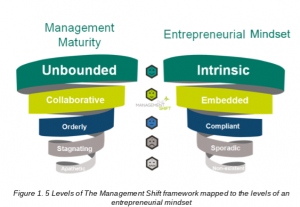Professor Vlatka Ariaana Hlupic, Professor of Leadership and Management at Hult International Business School (Ashridge), explains how businesses, their leaders, and employees must adapt to changing times.
The tsunami of change is coming. The world is changing rapidly, and it is up to us to change with it. Leaders, employees and organisations need to adopt an entrepreneurial mindset to succeed in this new world.
We, as an evolving human collective, can no longer tolerate leadership and management approaches characterised by "command-and-control", where people are treated as cogs in a machine and their initiatives are suppressed. Organisations that want to survive and thrive in the new world emerging, need to abandon hierarchical management approaches and equip their employees with an entrepreneurial mindset.
Management styles are not the only factor that can affect an entrepreneurial climate. A company's culture is just as important. For example, Google's culture is one of "20% time" where employees are encouraged to spend 20% of their work time on personal projects. This has led to some successful products including Gmail, Google News, and AdSense.
Research By The Management Shift
According to the research outlined in my book The Management Shift, individuals and organisations progress through five levels of mindset and organisational culture.
The five-level Management Shift model maps organisations on a five-level scale from Level 1 (lifeless mindset and apathetic culture) to Level 5 (limitless mindset and unbounded culture). These levels are also called management maturity stages, and they correspond to the different stages of an entrepreneurial mindset as shown in Figure 1.

At Level 1, a dominant mindset is 'Lifeless' and the corresponding organisational culture is 'Apathetic'. Not much gets done as people are too depressed to do anything and there is a lot of fear and blame, culture and leadership style could be toxic. At Level 2 the individual mindset is 'Reluctant' and culture is 'Stagnating': people do the minimum they can get away with just to get paid. At Level 3, the individual's mindset is 'Controlled' and organisational culture is 'Orderly'. Leadership style is based on traditional command and control, employees are micromanaged and they do what they are told to do.
A radical shift in performance, innovation and engagement happens when a critical mass of employees move from Level 3 to Level 4. The dominant mindset among employees becomes 'enthusiastic' and the culture becomes 'collaborative'. Leaders lead by letting go of formal power, they create psychological safety to support experimentation with new ideas, there is a strong teamwork ethos and employees feel purposeful and passionate about their work. Employees are empowered to think of new services, new technologies, new ways of working, within a collaborative environment.
Employees at Level 4 can occasionally reach Level 5 where the mindset becomes 'Limitless' and the culture is 'Unbounded'. Anything seems possible to achieve at this level, and amazing innovations materialise. Levels 4 and 5 provide an environment where companies can experience more innovation, value creation and better engagement, and where entrepreneurial mindsets thrive.
At each of these five levels, there is a different drive for an entrepreneurial mindset. At Level 1 entrepreneurial thinking is almost non-existent as people are focused on survival. At Level 2 it is random and sporadic, almost accidental. At Level 3 it is compliant, as employees attempt entrepreneurial tasks only when asked to.
At Level 4 entrepreneurial thinking becomes embedded in organisational culture. At this level employees have the autonomy to experiment with new ideas, they can make decisions based on their knowledge rather than a formal position in organisational hierarchy, and they collaborate with diverse teams. Finally, at Level 5 entrepreneurial mindset becomes intrinsic and there are no limits in thinking about what can be achieved.
In the ‘VUCA on steroids’ post-Covid world, organisations who do not adopt a Level 4 culture simply won’t survive. An entrepreneurial climate cannot be produced with ‘command and control’ mindsets and autocratic leadership styles, in which people are looking for a rulebook rather than new opportunities and have little autonomy to try new ideas.
There are several things that leaders can do to promote an entrepreneurial mindset in their company:
1) Encourage people to start their own small side projects where they can experiment with new ideas and approaches.
2) Create a hybrid workspace where creativity and innovation flow freely by giving autonomy, freedom and inspiration.
3) Make sure that people have opportunities for growth by helping them plan their career development over time.
4) Understand the connection between the causes and the effects of culture and mindsets and the immense value of operating at Level 4.
5) Help to maintain discipline through a system of accountability, honest communication, and adherence to the organisation’s positive values and higher purpose.
Leaders and organisations that can equip employees with entrepreneurial mindsets remain the key driving force for economic and social prosperity in the emerging world.
About the author: Professor Vlatka Ariaana Hlupic is Professor of Leadership and Management at Hult International Business School (Ashridge) and Founder and CEO of Management Shift Solutions Limited, a leading-edge training, coaching and consulting company.











